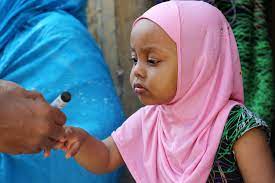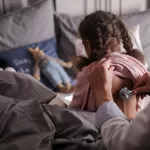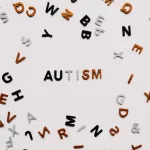
Outbreak at a glance
On 12 November 2022, Indonesia’s Ministry of Health notified WHO of a confirmed case of circulating vaccine-derived poliovirus type 2 (cVDPV2) with acute flaccid paralysis (AFP) from Pidie district in Aceh province. Field investigations were immediately launched by local and national public health authorities, with support from partners of the Global Polio Eradication Initiative. On 28 November, the Ministry of Health launched an immunization campaign for children under the age of 13 years in the affected areas.
Description of the outbreak
On 12 November 2022, Indonesia’s Ministry of Health notified WHO of a confirmed case of VDPV2. The case was a 7-year-old boy from Pidie district in Aceh province, who developed AFP on 9 October 2022. The case had not received oral polio vaccine (OPV) or inactivated polio vaccine (IPV) and had no travel history or contact with those who had traveled. On 25 November 2022, three more genetically related isolates of cVDPV2 were reported based on the laboratory results of stool samples taken from three healthy children who were in the same community but not close contacts of the confirmed case. Sequencing results from Biofarma lab showed 25 nucleotide changes for the AFP case and 25 to 26 nucleotide changes for the three asymptomatic children. These results are evidence of transmission of the virus and meets the criteria to be classified as circulating VDPV2 (cVDPV2). In the past in Indonesia, a cVDPV type 1 outbreak was reported in Papua province in 2019.
Aceh province has very low polio vaccination coverage in the routine immunization programme; however, coverage is also low in several other provinces in Indonesia, including three provinces nearby Aceh (North Sumatera, West Sumatera and Riau). In 2021, in Aceh province, bivalent oral polio vaccine (OPV3) coverage was 50.9%, and IPV 28.2%. and for Pidie district the coverage was 17.7% for OPV3 and 0.5% for IPV. There is low population immunity against all polioviruses but primarily type 2 in children born after the switch from the trivalent to bivalent OPV in April 2016.
Epidemiology of Poliomyelitis
Polio is a highly infectious disease that largely affects children under five years of age, causing permanent paralysis (approximately 1 in 200 infections) or death (2-10% of those paralyzed).
The virus is transmitted by person-to-person, mainly through the fecal-oral route or, less frequently, by a common vehicle (e.g., contaminated water or food) and multiplies in the intestine, from where it can invade the nervous system and cause paralysis.
The incubation period is usually 7–10 days but can range from 4–35 days. Up to 90% of those infected are either asymptomatic or experience mild symptoms and the disease usually goes unrecognized.
Vaccine-derived poliovirus is a well-documented strain of poliovirus mutated from the strain originally contained in OPV. OPV contains a live, weakened form of poliovirus that replicates in the intestine for a limited period, thereby developing immunity by building up antibodies. On rare occasions, when replicating in the gastrointestinal tract, OPV strains genetically change and may spread in communities that are not fully vaccinated against polio, especially in areas where there is poor hygiene, poor sanitation, or overcrowding. The lower the population immunity, the longer this virus survives and the more genetic changes it undergoes.
In very rare instances, the vaccine-derived virus can genetically change into a form that can cause paralysis as does the wild poliovirus – this is what is known as a vaccine-derived poliovirus (VDPV). The detection of VDPV in at least two different sources and at least two months apart, that are genetically linked, showing evidence of transmission in the community, should be classified as ‘circulating’ vaccine-derived poliovirus type 2 (cVDPV2). Circulating vaccine-derived poliovirus type 2 continues to affect different areas of the world, notably in the African Region.
Public health response
The Ministry of Health has publicly announced the outbreak, and on 28 November, immunization campaigns were launched for 1.2 million children under the age of 13 years in the province of Aceh.
Risk assessment and field investigations were immediately launched and are still ongoing by the local and national public health authorities, with support from the Global Polio Eradication Initiative (GPEI) partners, including a more detailed assessment of the origin of the isolated viruses.
The Ministry of Health, with support from WHO, UNICEF and other partners, is undertaking strong measures to stop the transmission. Measures include enhanced surveillance- active search for AFP cases at health facilities and communities, assessment of OPV/IPV coverage through a rapid community survey in a sample of 200 households, and training on the surveillance guidelines for the use of novel oral polio vaccine type 2 (nOPV2).
The WHO Director General approved the release of the nOPV2 for rapid response on 25 November 2022 and a rapid vaccination response was initiated on 28 November in Pidie district (the affected district) with approximately 95 603 children aged under 13 years to be vaccinated.
A rapid response vaccination campaign was launched in Aceh province for those aged zero to 12 years on 5 December 2022. Large-scale supplementary immunization activities (SIAs) with nOPV2 are proposed for those aged zero to 12 years in Aceh and zero to four years in North Sumatera, West Sumatra, and Riau in the first week of January 2023 and the first week of February 2023.
Advocacy campaigns, risk communication messaging, and social mobilization have been implemented.
WHO risk assessment
WHO assesses the risk to be high at the national level due to low polio vaccination coverage in Aceh and other provinces in Indonesia, the susceptibility of the population to poliovirus type 2 after switching from trivalent oral polio vaccine (tOVP) to bOPV in April 2016 combined with low uptake of inactivated polio vaccine (IPV), sub-optimal surveillance capacity, and vaccine hesitancy among the at-risk population.
The detection of cVDPVs highlights the importance of maintaining high levels of routine vaccination coverage everywhere to minimize the risk and consequences of the circulation of any poliovirus, as well as the need to ensure quality surveillance for early detection of any poliovirus.
WHO advice
It is important that all countries, in particular those with frequent travel and contacts with polio-affected countries and areas, strengthen surveillance for AFP cases and commence any planned expansion of environmental surveillance in order to rapidly detect any new virus importation and to facilitate a rapid response. Countries, territories and areas should also maintain uniformly high routine immunization coverage at the district level to minimize the consequences of any new virus introduction.
WHO’s International travel and health recommends that all travellers to polio-affected areas be fully vaccinated against polio.
As per the advice of the Emergency Committee convened under the International Health Regulations (2005) on the international spread of poliovirus, countries affected by poliovirus transmission are subject to Temporary Recommendations. To comply with the Temporary Recommendations issued under the PHEIC, any country that have had an importation of cVDPV2 with local transmission should (i) declare the outbreak as a national public health emergency (ii) encourage residents and long-term visitors to receive a dose of IPV four weeks to 12 months prior to international travel, (iii) ensure that travellers who receive such vaccination have access to an appropriate document to record their polio vaccination status, (iv) further intensify efforts to increase IPV immunization coverage, including sharing coverage data, and (v) intensify regional cooperation and cross border coordination to enhance surveillance for prompt detection of poliovirus, and vaccinate refugees, travellers and cross border populations, according to the advice of the Advisory Group.
WHO does not recommend any travel and/or trade restrictions to Indonesia based on the information available for this current event.
Further information
- Global Polio Eradication Initiative (GPEI)
- The Global Polio Laboratory Network (GPLN)
- WHO Polio Factsheet
- WHO/UNICEF estimates of national immunization coverage
- GPEI: Fact sheet: Vaccine-derived polioviruses
- GPEI Public health emergency status
- International Travel and Health
- Standard operating procedures: responding to a poliovirus event or outbreak, version 3.1.
- Statement of Thirty-third Polio IHR Emergency Committee dated 1 November 2022
- Fifteenth Meeting of the WHO South-East Asia Regional Certification Commission for Poliomyelitis Eradication
Citable reference: World Health Organization (19 December 2022). Disease Outbreak News; Circulating vaccine-derived poliovirus type 2 (cVDPV2)-Indonesia. Available at: https://www.who.int/emergencies/disease-outbreak-news/item/2022-DON430











